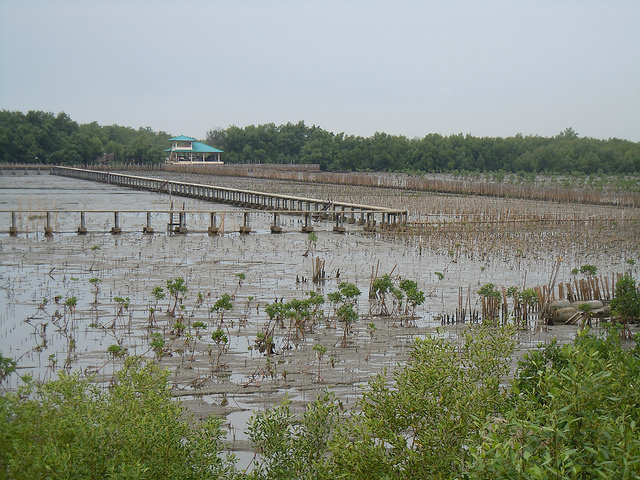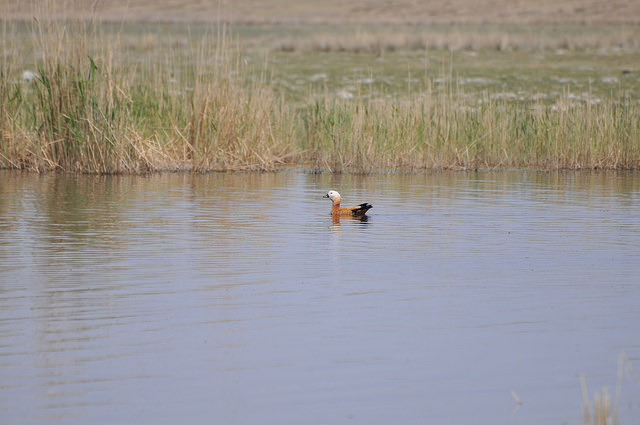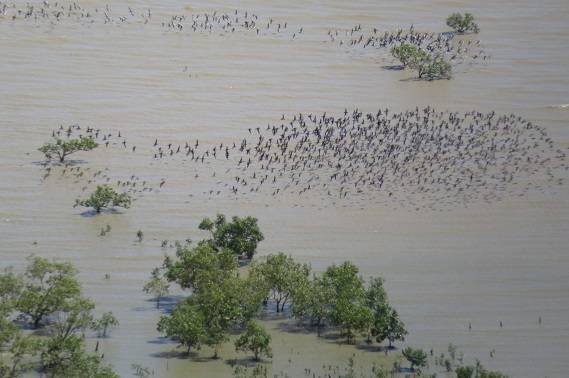Judit Szabo, Science Officer
EAAF114: Dashinchilen Tsagaan Wetland – Mongolia
This central Mongolian site is a complex of spring-fed lakes of variable depth and salinity as well as marshes with reed and sedge. It is an important breeding site for many cranes, anatids and shorebirds and a significant stopover sites for waterbirds that breed further to the north. Most important breeding species are Swan Goose (Anser cygnoid) with over 1400 counted in August 2014, White-naped crane (Grus vipio) – six in 2012 August. Non-breeding species for which the site qualifies as internationally important are Spotted Redshank (Tringa erythropus) 2500 birds in August 2012, Pied Avocet (Recurvirostra avosetta) nearly 1500 in 2012. Other species in significant numbers are Pacific Golden Plover (Pluvialis fulva), Black-tailed Godwit (Limosa limosa) and Common Teal (Anas crecca). Threats to the site include overgrazing by domestic animals, fire and drought. Unregulated birding tourism to the site is also a potential threat.
EAAF115: Izu-numa and Uchi-numa (Japan)
This site comprises of two shallow freshwater lakes, Izu-numa and Uchi-numa, surrounded by paddy fields. This area provides a winter home to more than 60 thousand swans and geese, such as Greater White-fronted Goose (Anser albifrons), Bean Goose (Anser fabalis middendorffii), Whooper Swan (Cygnus cygnus) and Northern Pintail (Anas acuta). Reclamation has affected the site in the past: more than half of the water surface has been reclaimed by the 1960s and the surrounding wetlands have been converted to rice paddies. Currently Largemouth Bass (Micropterus salmoides) an invasive alien fish threatens native fish communities. Accumulation of radioactive materials is a potential threat.
EAAF116: Notsuke-hanto and Notsuke-wan (Japan)
Located in the east of Hokkaido, Notsuke-hanto is a fishhook-shaped sand spit in the Nemuro channel. Notsuke-wan is the bay formed between the sand spit and mainland Hokkaido. The large tidal flat and Zostera seagrass bed provide important habitat for staging for migratory birds, such as Ruddy Turnstone (Arenaria interpres), Grey-tailed Tattler (Heteroscelus brevipes), Mongolian Plover (Charadrius mongolus stegmanni), Whooper Swan (Cygnus cygnus), Brant Goose (Branta bernicla), and Greater Scaup (Aythya marila). Red-crowned Crane (Grus japonensis) breeds in the area. Erosion of the shoreline is affecting the habitat as well as overabundant native (Sika deer Cervus Nippon yesoensis) and introduced species such as crayfish (Pacifastacus leniusculus) and bumblebee (Bombus terrestris).
EAAF117: Gulf of Mottama – Myanmar
This bell shaped estuary site is extremely important for migratory waterbirds, hosting about 200,000 individuals from October to mid-April. The estuarine waters, intertidal mudflats, sandbars, muddy and sandy shorelines are salt marshes provide feeding and resting site to internationally important numbers of Spoon-billed Sandpiper (Calidris pygmaea), Spotted Greenshank (Tringa guttifer), Great Knot (Calidris tenuirostris), Eurasian Curlew (Numenius arquata), Black-tailed Godwit (Limosa limosa), Common Greenshank (Tringa nebularia), Common Redshank (Tringa totanus), Curlew Sandpiper (Calidris ferruginea), Broad-billed Sandpiper (Limicola falcinellus), Spotted Redshank (Tringa guttifer), Red-necked Stint (Calidris ruficollis), Lesser Sand Plover (Charadrius mongolus), Pacific Golden Plover (Pluvialis fulva), Kentish Plover (Charadrius alexandrinus), Lesser Adjutant (Leptoptilos javanicus), Painted Stork (Mycteria leucocephala), Black- headed Ibis (Threskiornis melanocephalus). Besides illegal fishing in the site, there is also illegal take of birds. Erosion is changing the habitat and might cause relocation of the human inhabitats. Waste management is a problem for the local communities. There is a potential for residential and commercial development as well as oil and gas drilling.
EAAF118: Indawgyi Wildlife Sanctuary – Myanmar
This natural freshwater lake is about 10 by 24 km large with shallow as well as deeper areas. The site holds over 20,000 migratory and resident waterbirds and provides important habitat for freshwater fish and turtle species. Large numbers of ducks are present, such as Tufted Duck (Aythya fuligula), Ferruginous Duck (Aythya nyroca), Ruddy Shelduck (Tadorna ferruginea). Lesser Adjutant (Leptoptilos javanicus) occasionally visits. Rice cultivation in the lake basin provides habitat for Sarus Crane (Grus antigone) and Common Crane (Grus grus). The use of pesticides and fertilisers in the surrounding agricultural areas is of concern as well as contamination from gold mining. Overfishing and tourism are potential threats.
EAAF119: Moeyungyi Wetland Wildlife Sanctuary – Myanmar
This site is a shallow man-made reservoir that floods in the wet season, providing habitat to over 20,000 migratory waterbirds, including Baer’s Pochard (Aythya baeri) and the resident Sarus Crane (Grus antigone), as well as >1% of the regional population of Northern Pintail (Anas acuta). In the dry season the lake turns into areas of mud, grassland and marsh with some shallow permanent water. Invasive alien plant species, illegal fishing and the effect of domestic animals (ducks, cattle and water buffalo) might threaten the site.
EAAF120: South-East Gulf of Carpentaria – Karumba-Smithburne (DeltaDowns) – Australia
This site comprises intertidal mud and sandflats backed by mangroves, salt flats, shelly beaches and marine areas with a high density of migratory shorebirds – over 20,000 individuals of over 20 species. Great Knot (Calidris tenuirostris), Red Knot (Calidris canutus), Black-tailed Godwit (Limosa limosa melanuroides) and Greater Sand Plover (Charadrius leschenaultii) visit the site in internationally important numbers. Substantial numbers of Far Eastern Curlew (Numenius madagascariensis) are also present. Besides small-scale recreational and commercial fishing and limited cattle grazing there is no current land use in the site. Tropical cyclones have affected the characteristics of the site in the past and might occur in the future.
EAAF121: Pak Thale Laem Phak Bia – Thailand
Floodplains and open land predominate this site, most of which is used as salt plans, coastal agriculture and irrigation-dependent paddy fields. Mangrove forests back up coastal areas. This site supports over 20,000 resident and migratory shorebirds and other waterbirds, including significant numbers of globally threatened species, such as Spoon-billed Sandpiper (Calidris pygmaea), Spotted Greenshank (Tringa guttifer), Far Eastern Curlew (Numenius madagascariensis) and Great Knot (Calidris tenuirostris), as well as Near Threatened species, such as Asian Dowitcher (Limnodromus semipalmatus), Painted Stork (Mycteria leucocephala) and Spot-billed Pelican (Pelecanus philippensis). Coastal erosion as well as response to it has changed the ecological character of the site. Invasive alien plants as well as overharvesting of fish and shellfish affect the ecosystem.
 This site in the Gulf of Thailand is comprised of mudflats, sandy beaches, salt pans and canals. There is considerable areas of aquaculture for cockle and mussels, mangrove forests and open water. Intertidal mudflats provide feeding and resting habitat for migratory shorebirds, including Spoon-billed Sandpiper (Calidris pygmaea), Spotted Greenshank (Tringa guttifer), Great Knot Calidris tenuirostris), Asian Dowitcher (Limnodromus semipalmatus), Black-tailed Godwit (Limosa limosa), Bar-tailed Godwit (Limosa lapponica), Eurasian Curlew (Numenius arquata) and Far Eastern Curlew (Numenius madagascariensis). Painted Storks (Mycteria leucocephala) are also regular visitors. Erosion has affected the site in the past and habitat has been converted to aquaculture. Residential development is a possible threat that can cause further habitat loss.
This site in the Gulf of Thailand is comprised of mudflats, sandy beaches, salt pans and canals. There is considerable areas of aquaculture for cockle and mussels, mangrove forests and open water. Intertidal mudflats provide feeding and resting habitat for migratory shorebirds, including Spoon-billed Sandpiper (Calidris pygmaea), Spotted Greenshank (Tringa guttifer), Great Knot Calidris tenuirostris), Asian Dowitcher (Limnodromus semipalmatus), Black-tailed Godwit (Limosa limosa), Bar-tailed Godwit (Limosa lapponica), Eurasian Curlew (Numenius arquata) and Far Eastern Curlew (Numenius madagascariensis). Painted Storks (Mycteria leucocephala) are also regular visitors. Erosion has affected the site in the past and habitat has been converted to aquaculture. Residential development is a possible threat that can cause further habitat loss.
More photos of Flyway Network Sites are available here.






